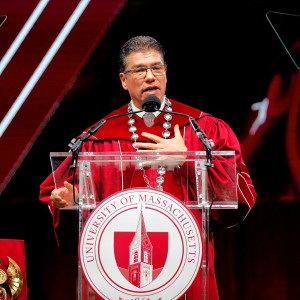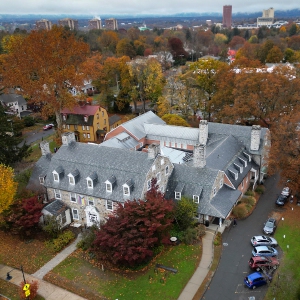Petition backing Nipmuc garners support
| Published: 01-02-2023 11:28 AM |
BELCHERTOWN — An online petition advocating for the return of 400 acres of state-owned farmland in Belchertown back to the Nipmuc people has garnered more than 900 signatures in less than six days.
The Change.org petition, which was launched by a group of Nipmuc leaders, local residents and members of the Western Mass Chapter of Showing Up for Racial Justice, is aimed at state representatives and asks them to work toward the rematriation of the Lampson Brook Farm back into the tribe’s hand.
“We decided to demonstrate that there is a broad base of support to make it happen,” said Molly Merrett, an organizer for Western Mass Chapter of Showing Up for Racial Justice.
Since the 1980s, Lampson Brook Farm has maintained a lease with the New England Small Farm Institute, but that lease is set to expire in 2023.
The Nipmuc people have expressed an interest in becoming the next stewards of this land and have developed a plan to start an “agrihood” — which integrates farming and gardening into a residential neighborhood — through the Nipmuc Nation/Hassanamisco Band’s nonprofit, the Nipmuc Indian Development Corp.
In January 2021, Gov. Charlie Baker signed a law that provides permanent protection for the land, establishes a board of directors and spells out guidelines for the future of the property, including new owners being sought through a request for proposal process.
The law specifically mentions the longtime farm nonprofit and includes a section about transferring a parcel to the nonprofit, but does not include any reference to the original Indigenous inhabitants. The absence of recognition for the Nipmucs and the inclusion of specific restrictions on use of the parcels led to a number of people calling for the legislation to be changed over the past two years. However, there has been no movement in amending the legislation.
“The timeline that’s described in the legislation has passed without a new owner being chosen, so we’d like to see the legislation rewritten to pass ownership of several parcels of the property to the Nipmuc,” Merrett said.
Article continues after...
Yesterday's Most Read Articles
 Granby Bow and Gun Club says stray bullets that hit homes in Belchertown did not come from its range
Granby Bow and Gun Club says stray bullets that hit homes in Belchertown did not come from its range
 Super defers Amherst middle school principal pick to successor; one finalist says decision is retaliation for lawsuit
Super defers Amherst middle school principal pick to successor; one finalist says decision is retaliation for lawsuit
 ‘Home away from home’: North Amherst Library officially dedicated, as anonymous donor of $1.7M revealed
‘Home away from home’: North Amherst Library officially dedicated, as anonymous donor of $1.7M revealed
 Political newcomer defeats Shores Ness for Deerfield Selectboard seat
Political newcomer defeats Shores Ness for Deerfield Selectboard seat
 A DIY approach to flying: Local pilots build and help build their own aircraft
A DIY approach to flying: Local pilots build and help build their own aircraft
 Back to the screen: Amherst authors’ popular ‘Spiderwick Chronicles’ gets a new streaming adaptation
Back to the screen: Amherst authors’ popular ‘Spiderwick Chronicles’ gets a new streaming adaptation
Tammy Toad Ryan, who is on the board of directors and is the vice-chairperson of the Belchertown Agricultural Commission, said that the board of directors is currently drafting the request for proposals, but was unsure of when it would be released.
The petition also urges signers to put pressure on so-called decision makers, including Belchertown’s representatives, the newly elected state Sen. Jake Olivera, D-Ludlow, and state Rep. Aaron Saunders, D-Belchertown; the Lampson Brook Farm Board of Directors and the state Division of Capital Asset Management and Maintenance.
“We think that demonstrating a broad base of support for this effort will put needed pressure on lawmakers and others to take action,” Merrett said.
Another issue with the legislation is how land ownership is spelled out.
“To have the Nipmuc people apply and be selected through the RFP (request for proposal) process, there are a lot of inherent problems in how the legislation is written. It’s not compatible with Indigenous sovereignty,” she said.
Nipmucs were not the only Indigenous community in what is now called Belchertown, according to Cheryll Toney Holley, sonksq (female leader) of the Nipmuc Nation and Hassanamisco Band.
“A major trail once ran through the land used by multiple peoples. No permanent village existed in this space, but the land was used to grow food — for centuries,” said Holley in a statement.
The land was previously territory for both the Nipmuc and Pocumtuc tribes. The Pocumtuc is a no longer existing tribe as a result of colonial violence, she said. Survivors of the Pocumtuc joined the Nipmuc or Abenaki.
Nipmuc territory extended past present-day state boundaries and included the majority of Massachusetts as well as parts of Connecticut and Rhode Island before colonization. Currently, the state-recognized tribe has 3.5 acres at the Hassanamisco Reservation in Grafton.
Though land has been returned to tribal owners in several states such as Ohio, California and Virginia, through what’s known as the Land Back movement, the effort has yet to take hold in Massachusetts.

 Sharing a few notes: High schoolers coaching younger string players one on one
Sharing a few notes: High schoolers coaching younger string players one on one Reyes takes helm of UMass flagship amid pro-Palestinian protests
Reyes takes helm of UMass flagship amid pro-Palestinian protests Sole over-budget bid could doom Jones Library expansion project
Sole over-budget bid could doom Jones Library expansion project Amherst poised to hire police department veteran as new chief
Amherst poised to hire police department veteran as new chief 